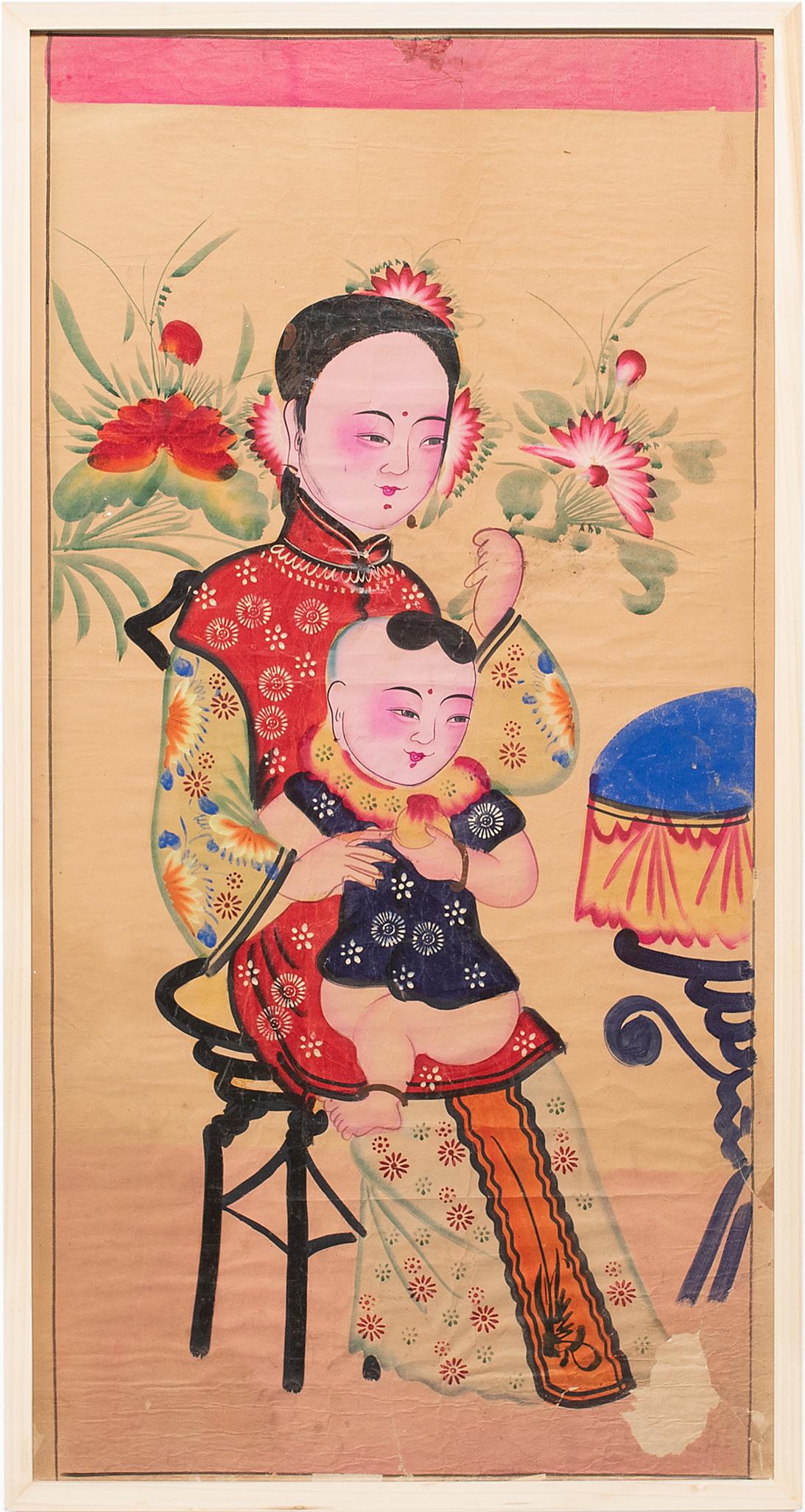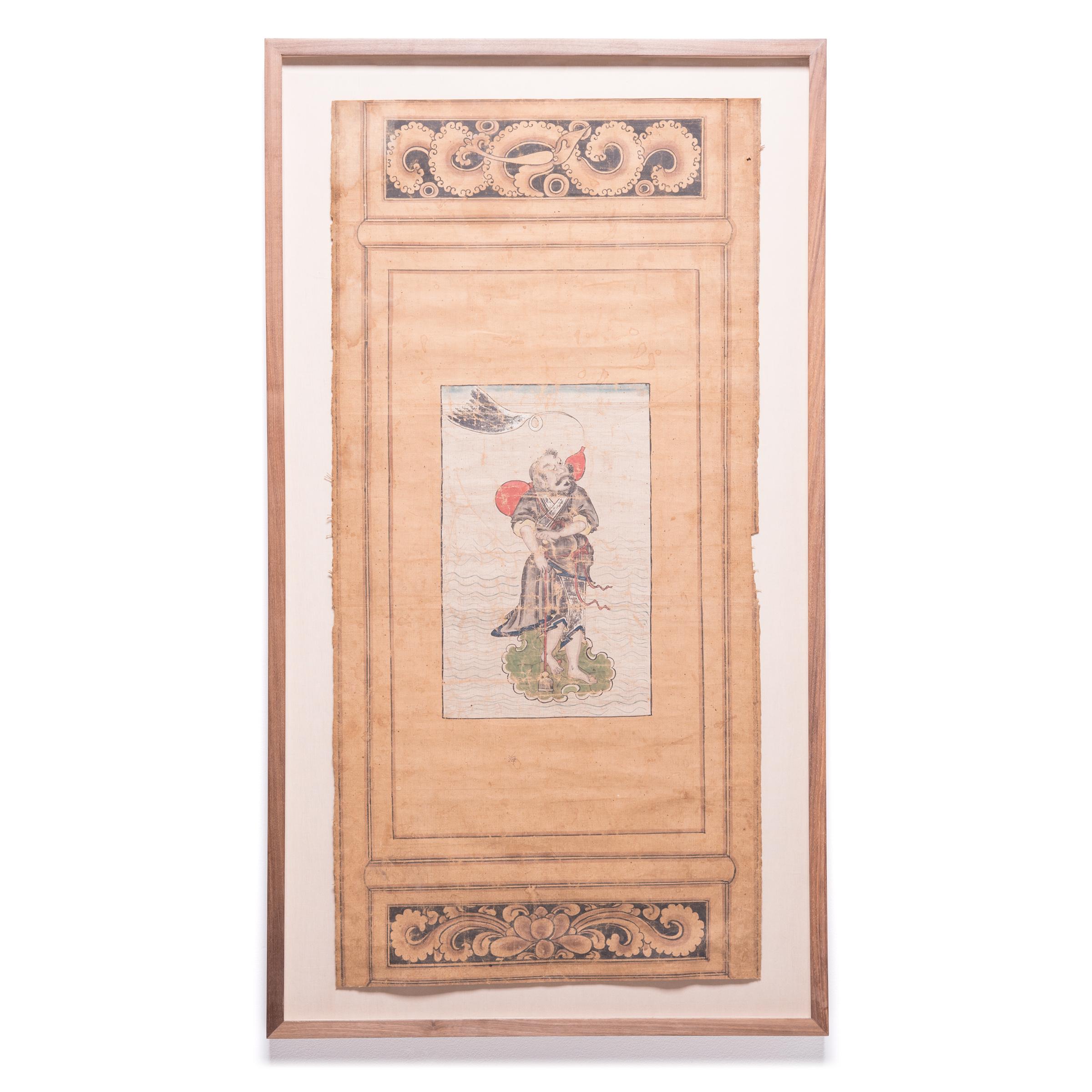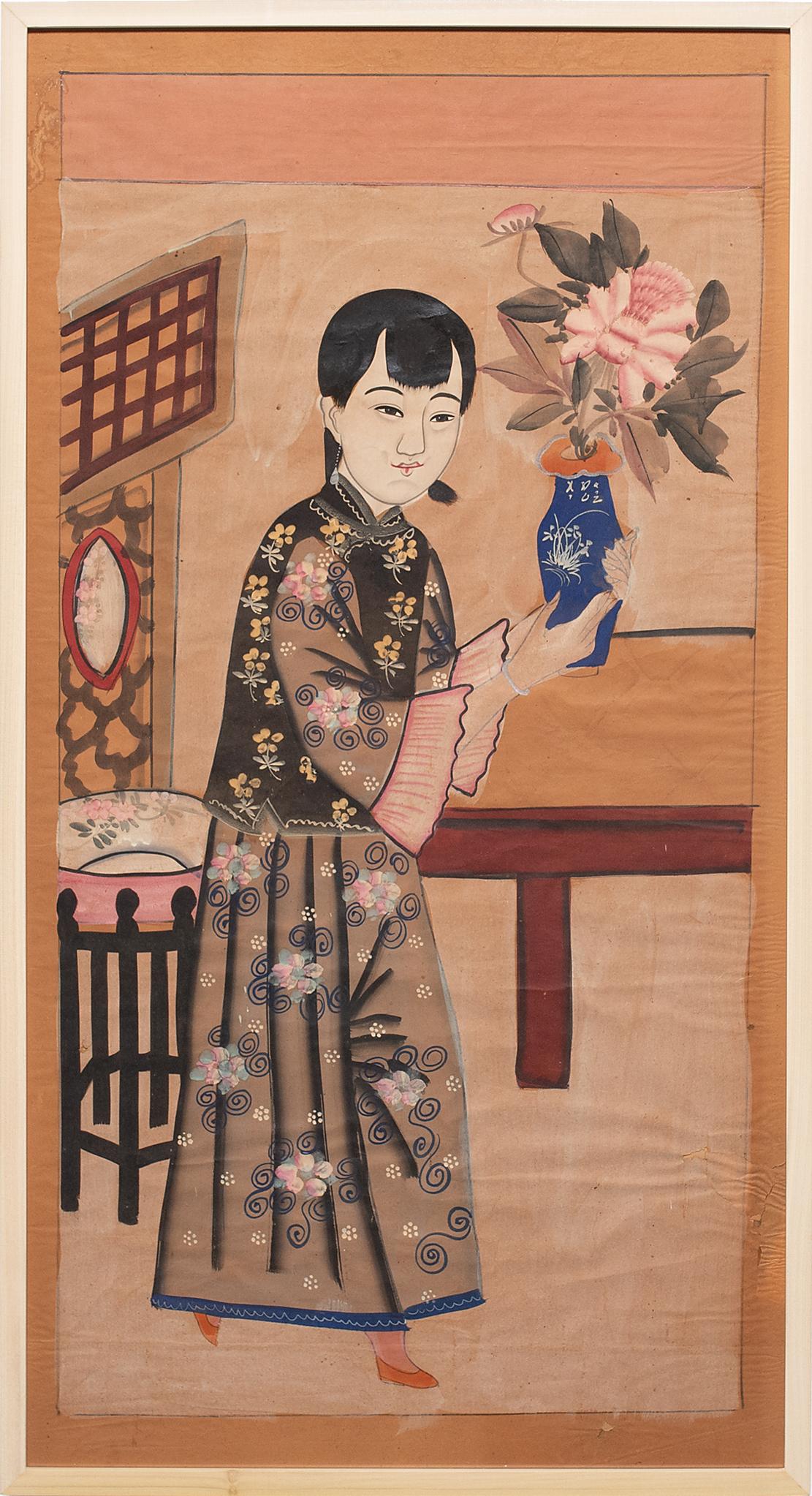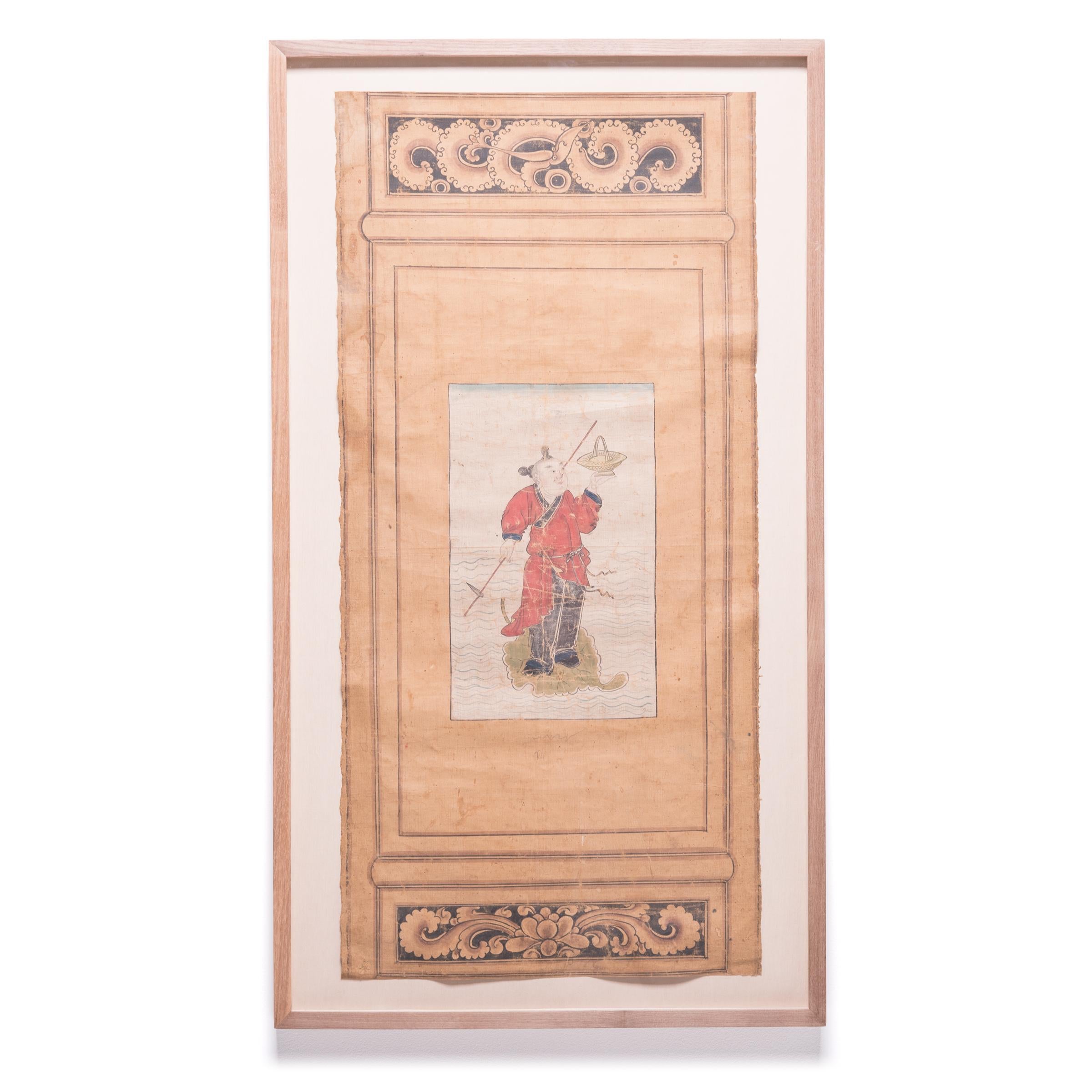Items Similar to Miniatures with Text from the "Legend of Phra Malai"
Want more images or videos?
Request additional images or videos from the seller
1 of 9
UnknownMiniatures with Text from the "Legend of Phra Malai"
About the Item
Unknown Artist, Thailand, 19th century
Miniatures with Text from the "Legend of Phra Malai"
Double folio; ink, color and gold leaf, c. 1900
Unsigned
Script: Khmer (Cambodian) These texts are written in Khom script, a variant of Khmer script often used in Central Thai religious manuscripts.
Paired devas (lesser gods) on throne-like plinths addorse Khmer (Cambodian) script containing tales of Phra Malai, a Sri Lankan arhat or Buddhist saint known for his travels to hell. There, the compassionate monk gave teachings and comfort to sufferers. Phra Malai stories taught the karmic effects of human actions to the faithful as well as conveying Maitreya's message of hope for attaining nirvana.
Though known in neighboring countries, the stories of Phra Malai achieved their greatest popularity and influence in Siam (present day Thailand)
Condition: Very good
Sight window) size: 11-1/8 x 27 inches
Frame size: 19-5/8 x 34-7/8 x 3/4 inches
The legend of Phra Malai, a Buddhist monk of the Theravada tradition said to have attained supernatural powers through his accumulated merit and meditation, is the main text in this 19th-century Thai samut khoi (folding book) held in the Thai, Lao, and Cambodian Collections of the British Library. Phra Malai figures prominently in Thai art, religious treatises, and rituals associated with the afterlife, and the story is one of the most popular subjects of 19th-century illustrated Thai manuscripts. The earliest surviving examples of Phra Malai manuscripts date back to the late 18th century, although it is assumed that the story is much older, being based on a Pali text. The legend also has some parallels with the Ksitigarbha Sutra. The Thai text in this manuscript is combined with extracts in Pali from the Abhidhammapitaka, Vinayapitaka, Suttantapitaka, Sahassanaya, and illustrations from the Thotsachat (Last ten birth tales of the Buddha). Altogether, the manuscript has 95 folios with illustrations on 17 folios.
- Dimensions:Height: 11.13 in (28.28 cm)Width: 27 in (68.58 cm)
- Medium:
- Period:
- Condition:
- Gallery Location:Fairlawn, OH
- Reference Number:
About the Seller
5.0
Recognized Seller
These prestigious sellers are industry leaders and represent the highest echelon for item quality and design.
Platinum Seller
These expertly vetted sellers are 1stDibs' most experienced sellers and are rated highest by our customers.
Established in 1978
1stDibs seller since 2013
713 sales on 1stDibs
Typical response time: 1 hour
Associations
International Fine Print Dealers Association
- ShippingRetrieving quote...Ships From: Akron, OH
- Return PolicyA return for this item may be initiated within 10 days of delivery.
More From This SellerView All
- Two Miniatures and text from the "Legend of Phra Malai"Located in Fairlawn, OHUnknown Artist, Thailand, 19th century Two Miniatures and text from the "Legend of Phra Malai" Ink and color on paper, c, 1900 Unsigned as usual Script: Aksar Chrieng or Khmer These texts are written in Khom script, a variant of Khmer script often used in Central Thai religious manuscripts. Phra Malai was a Budhist monk whose meditations permitted him to travel to heaven and hell. Condition: Good, with minor staining to text Sight (window) size: 11-1/8 x 27 inches Frame size: 19-3/4 x 35 x 3/4 inches Framed in solid cherry wood with archival, acid free materials The legend of Phra Malai, a Buddhist monk of the Theravada tradition said to have attained supernatural powers through his accumulated merit and meditation, is the main text in this 19th-century Thai samut khoi (folding book) held in the Thai, Lao, and Cambodian Collections of the British Library. Phra Malai figures prominently in Thai art...Category
19th Century Other Art Style Figurative Drawings and Watercolors
MaterialsPigment
- The Dark Aspect of the Great Goddess DeviLocated in Fairlawn, OHThe Dark Aspect of the Great Goddess Devi Pigment on paper (unfinished), 19th century Unsigned as is usual Condition: Good color Voids at edges of the sheet Image s...Category
19th Century Rajput Figurative Drawings and Watercolors
MaterialsPigment
- The Mouth of HoneyBy George Wesley BellowsLocated in Fairlawn, OHThe Mouth of Honey Lithographic crayon and mixed media on paper mounted to support paper Initialed by the artist "GB" bottom center on image. (see photo) Titled in pencil in bottom m...Category
1920s Ashcan School Drawings and Watercolor Paintings
MaterialsCrayon
- Untitled (Joe and Patsy LoGuidice at the Casa Luna)By Larry RiversLocated in Fairlawn, OHUntitled (Joe and Patsy LoGuidice at the Casa Luna) Pastel, charcoal and colored pencil, 1970-1975 Signed lower right in pencil: Larry Rivers Inscribed on the rabbit of the original white frame: LOGUIDICE in ink Provenance: Private Collection, New York (Westchester County) Condition: Excellent Image size: 31 1/2 x 24 1/2 inches Frame size: 39 1/2 x 32 1/2 inches Note: The image depicts Ciprian “Joe” LoGuidice (d. 2008) and his wife Patsy with their dog (Golden Retriever?) in their famous house Casa Luna, located in Zihautenajo, Mexico. Joe LoGuidice had a most colorful life as stated in his memorial posting by Pam Barkentin: Ciprian "Joe" LoGiudice, of Los Angeles and Zihautanejo, Mexico Art Dealer, Political Activist, Environmentalist, Film Producer, and Executor of the Terry Southern Estate died at home in Los Angeles on September 3, 2008. A major benefactor of the Chicago Seven, he hosted a benefit for the anti-war activists at his Ontario Street Gallery in Chicago and later harbored the fugitive Abbie Hoffman in Zihautenajo where Joe designed and built the famous Casa Luna, the house without walls, in a compound that included Larry River's Studio as well as the garden where Julian Schnabel painted with the assistance of Ramon Pedrazo, Joe's gardener and the husband of his faithful housekeeper, Concha Pedrazo. Here at Casa Luna, from the early seventies on, Joe and his wife, Patsy, generously hosted friends and enemies alike with great enthusiasm and humor.Most recently, through his participation in "Save the Bay", Joe was instrumental in preventing cruise ships from anchoring in the Bay of Zihautanejo. He was also producing "Five Easy Steps to Metaphysical Fitness", a documentary about the philosopher/comic, Emily Levine. Christo's first wrapping of a building in the United States, the Chicago Museum of Art, was produced by LoGiudice. Other artists he represented, in both his Chicago and New York Galleries, included John Chamberlin, Larry Poons, Mark de Suvero, Leon Golub and Jules Olitski. Joe is survived by his wife of 25 years, Patsy Cummings. An important work by Rivers showing his friend and art dealer in their famous house, Casa Luna, in Mexico. The cultural import of LoGuidice cannot be understated. He was a major figure in the New York, Chicago, and Los Angeles art cultures. The artist’s who were his friends and guests were many of the leading icons of late 20th century art. Larry Rivers Larry Rivers in 1961 Born Yitzroch Loiza Grossberg August 17, 1923 Bronx, New York, U.S. Died August 14, 2002 (aged 78) Southampton, New York, U.S. Nationality American Education Hans Hofmann School Known for Painting, sculpture Movement East Coast figurative painting, new realism, pop art Spouse(s) Augusta Berger (m. 1945; div. 1946) Clarice Price (m. 1961; sep. 1967) Larry Rivers (born Yitzroch Loiza Grossberg, August 17, 1923 – August 14, 2002) was an American artist, musician, filmmaker and occasional actor. Rivers resided and maintained studios in New York City, Southampton, Long Island, and Zihuatanejo, Mexico. Early life Larry Rivers was born in the Bronx to Samuel and Sonya Grossberg, Jewish immigrants from Ukraine. From 1940–1945 he worked as a jazz saxophonist in New York City, changing his name to Larry Rivers in 1940 after being introduced as "Larry Rivers and the Mudcats" at a local pub. He studied at the Juilliard School of Music in 1945–46, along with Miles Davis, with whom he remained friends until Davis's death in 1991. Training and career Larry Rivers in 1961 Rivers is considered by many scholars to be the "Godfather" and "Grandfather" of Pop art, because he was one of the first artists to really merge non-objective, non-narrative art with narrative and objective abstraction. Rivers took up painting in 1945 and studied at the Hans Hofmann School from 1947–48. He earned a BA in art education from New York University in 1951. He was a pop artist of the New York School, reproducing everyday objects of American popular culture as art. He was one of eleven New York artists featured in the opening exhibition at the Terrain Gallery in 1955. During the early 1960s Rivers lived in the Hotel Chelsea, notable for its artistic residents such as Bob Dylan, Janis Joplin, Leonard Cohen, Arthur C. Clarke, Dylan Thomas, Sid Vicious and multiple people associated with Andy Warhol's Factory and where he brought several of his French nouveau réalistes friends like Yves Klein who wrote there in April 1961 his Manifeste de l'hôtel Chelsea, Arman, Martial Raysse, Jean Tinguely, Niki de Saint-Phalle, Christo, Daniel Spoerri or Alain Jacquet, several of whom left, like him, some pieces of art in the lobby of the hotel for payment of their rooms. In 1965 Rivers had his first comprehensive retrospective in five important American museums. His final work for the exhibition was The History of the Russian Revolution, which was later on extended permanent display at the Hirshhorn Museum and Sculpture Garden in Washington, DC. During 1967 he was in London collaborating with the American painter Howard Kanovitz. In 1968, Rivers traveled to Africa for a second time with Pierre Dominique Gaisseau to finish their documentary Africa and I, which was a part of the groundbreaking NBC series Experiments in Television. During this trip they narrowly escaped execution as suspected mercenaries.[citation needed] During the 1970s Rivers worked closely with Diana Molinari and Michel Auder on many video tape projects, including the infamous Tits, and also worked in neon. Rivers's legs appeared in John Lennon and Yoko Ono's 1971 film Up Your Legs Forever. Personal life Rivers married Augusta Berger in 1945, and they had one son, Steven. Rivers also adopted Berger's son from a previous relationship, Joseph, and reared both children after the couple divorced. He married Clarice Price in 1961, a Welsh school teacher who cared for his two sons. Rivers and Clarice Price had two daughters, Gwynne and Emma. After six years, they separated. Shortly after, he lived and collaborated with Diana Molinari, who featured in many of his works of the 1970s. After that Rivers lived with Sheila Lanham, a Baltimore artist...Category
1970s Contemporary Figurative Drawings and Watercolors
MaterialsPastel
- Stolen Moments #2By Darius StewardLocated in Fairlawn, OHStolen Moments #2 Watercolor on Twinrocker All Purpose Paper Signed with the artist's initials lower right (see photo) From the series: Stolen Moments Signed with the artist's "Yummy...Category
2010s Contemporary Portrait Drawings and Watercolors
MaterialsWatercolor
- Playing with Lives (First Responder)By Darius StewardLocated in Fairlawn, OHPlaying with Lives (First Responder) Watercolor on Arches paper, 2020 Signed with the artist's initials lower right Signed with the artist's embossed "Yummy" blindstamp lower right ...Category
2010s Contemporary Figurative Drawings and Watercolors
MaterialsWatercolor
You May Also Like
- Yangliuqing Longevity New Year Painting, c. 1920Located in Chicago, ILChinese New Year paintings (nian hua) are colorful folk paintings created to celebrate the annual Spring Festival. Drawn or printed by folk artists in regional studios, nian hua pain...Category
Early 20th Century Folk Art Figurative Paintings
MaterialsInk, Pigment, Paper
- Chinese Mythical Immortal Screen Painting, c. 1850Located in Chicago, ILSince the 12th century, people in China have used folding screens and doors to partition and decorate their homes - the vivid scenes backing the screens added life and color to a roo...Category
Mid-19th Century Figurative Paintings
MaterialsFabric, Ink, Pigment
- Chinese Mythical Immortal Screen Painting, c. 1850Located in Chicago, ILSince the 12th century, people in China have used folding screens and doors to partition and decorate their homes - the vivid scenes backing the screens added life and color to a roo...Category
Mid-19th Century Figurative Paintings
MaterialsFabric, Ink, Pigment
- Yangliuqing Peace & Prosperity New Year Painting, c. 1920Located in Chicago, ILChinese New Year paintings (nian hua) are colorful folk paintings created to celebrate the annual Spring Festival. Drawn or printed by folk artists in regional studios, nian hua paintings featured exaggerated characters with bright and contrasting colors. Put up around the home to beckon luck and happiness in the coming year, most paintings depicted mythical guardians, scenes from folk operas, or auspicious symbols of good luck. This New Year painting depicts a young woman holding a vase filled with peony blossoms. This combination of motifs is a visual idiom for "may you have peace and prosperity" (ping'an fu gui). The early 20th century painting is from the town of Yangliuqing, one of the leading producers of traditional New Year's paintings known for its combination of woodblock printing...Category
Early 20th Century Folk Art Figurative Paintings
MaterialsPaper, Ink, Pigment
- Chinese Mythical Immortal Screen Painting, c. 1850Located in Chicago, ILSince the 12th century, people in China have used folding screens and doors to partition and decorate their homes - the vivid scenes backing the screens added life and color to a roo...Category
Mid-19th Century Figurative Paintings
MaterialsFabric, Ink, Pigment
- Chinese Mythical Immortal Screen Painting, c. 1850Located in Chicago, ILSince the 12th century, people in China have used folding screens and doors to partition and decorate their homes - the vivid scenes backing the screens added life and color to a roo...Category
Mid-19th Century Figurative Paintings
MaterialsFabric, Ink, Pigment





